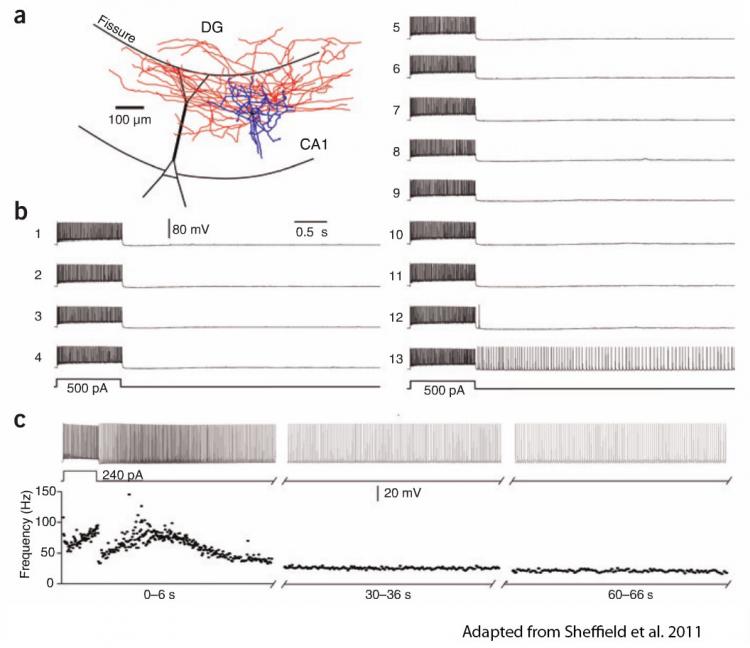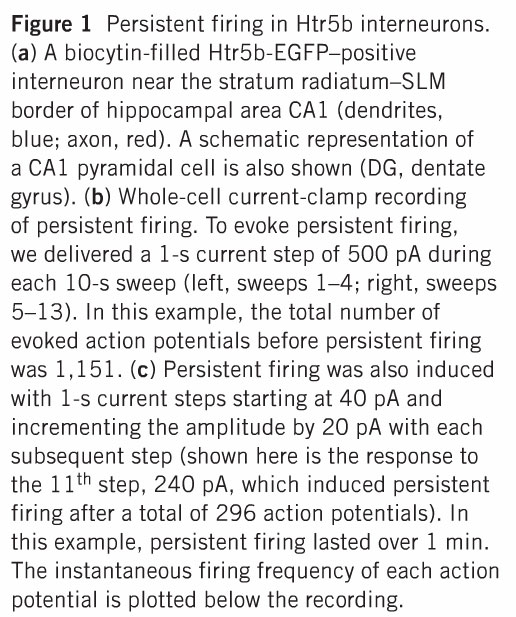The population of inhibitory interneurons in the brain is incredibly diverse. Nowhere is this more evident than in the hippocampus. Yet no theory of neural circuit function has been put forward that would require such diverse mechanisms for inhibition. Solving this problem will require that we understand more about the diverse properties and functions of inhibitory interneurons in neural circuits.
A few years ago we published a paper showing that some inhibitory interneurons in the hippocampus, when stimulated repeatedly, could begin to fire extensively, long after termination of the stimulus (Sheffield et al., 2011). A number of things were remarkable about this form of firing:
- It is triggered by slow integration of its own firing, usually requiring hundreds of action potentials that can occur over the course of a couple of minutes.
- Its onset is sudden, relative to the duration of stimulation required to trigger it.
- Its duration is long, with ~10-20 Hz persistent firing lasting on average about a minute.
- The persistent firing is generated in the axon, at distal locations, and the action potentials generated there propagate antidromically to the soma.
- In some cases, stimulation of one neuron triggers persistent firing in a neighboring, unstimulated neuron.
 Because of these properties, we dubbed this “retroaxonal barrage firing”. In a pharmacological study, we made some progress toward unraveling the mechanisms responsible for RaB firing, but we still have a long way to go.
Because of these properties, we dubbed this “retroaxonal barrage firing”. In a pharmacological study, we made some progress toward unraveling the mechanisms responsible for RaB firing, but we still have a long way to go.
Currently, Tara Deemyad is continuing our investigation of RaB firing, specifically testing the hypothesis that astrocytes could be involved in the generation of RaB firing, an idea that we proposed on the basis of our previous results (Sheffield et al. 2013).
The video below presents some of our previous findings on RaB firing.
References
Sheffield MEJ, Best TK, Mensh BD, Kath WL, Spruston N. Slow integration leads to persistent action potential firing in distal axons of coupled interneurons. Nature Neuroscience, 14:200-207, 2010.
Sheffield ME, Edgerton G, Heuermann RJ, Deemyad T, Mensh BD, Spruston N. Mechanisms of retroaxonal barrage firing in hippocampal interneurons. J Physiol., 591: 4793-805, 2013.
Figure legend

Further reading
Fishell G, Rudy B. Mechanisms of inhibition within the telencephalon: "where the wild things are". Annual Review of Neuroscience 34:535-67, 2011.
Kepecs A, Fishell G. Interneuron cell types are fit to function. Nature 505:318-26, 2014.
Klausberger T, Somogyi P. Neuronal diversity and temporal dynamics: the unity of hippocampal circuit operations. Science 321:53-7, 2008.
McBain CJ, Fishan A. Interneurons unbound. Nature Neuroscience 2:11-23, 2001.
Spruston N, McBain C. Chapter 5: Structural and functional properties of hippocampal neurons. In: The Hippocampus Book, Andersen P, Morris R, Amaral D, Bliss T, O’Keefe J, eds. Oxford University Press, pp. 133-201, 2007.
